Susan Signe Morrison's Blog
September 23, 2025
What Beowulf Character Are You?
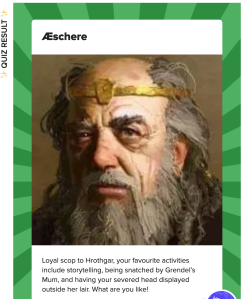
This is my quiz result. NOT Grendel’s Mother!
There’s a very silly quiz available on BuzzFeed which asks, “What Beowulf Character Are You?” Having written the novel, Grendel’s Mother: The Saga of the Wyrd-Wife, I figured I’d be a shoe-in for GM. But I got Aeschere instead. I think my mistake was falling for the following question:
“Cædmon wants you to go on an episode of Carpool Karaoke. What do you sing?”
I couldn’t help choosing: “Bohemian Rhapsody by Cwen.”
Oh well…maybe I DO have more in common with Aeschere. I’ll just have to take the quiz again. And again. And again…..
A shout out to Misty Schieberle for calling my attention to this: “Hwaet!”
September 19, 2023
1 Man, 1 Hour, One Amazing Performance of BEOWULF
John Heimbuch had students riveted, moved, amazed, amused, and entranced by his 1 man, 1 hour performance of BEOWULF.

No one scrolled on a cell phone, so committed were they to this unforgettable performance. Fellow medievalists, take note!
Thank you to John and his director, Amy Rummenie, who spoke to my classes about the poem, the play, and the performance. Surely more memorable than my teaching Old English grammar.

December 3, 2021
Manuscript Discovery: Grendel’s Mother and My Mother
 From the Table of Contents. Note how Joan has written “Hrunting” here.
From the Table of Contents. Note how Joan has written “Hrunting” here.I was flipping through the pages of my mother’s book from when she was a high school student in Chicago in the 1930s. I had held World Literature (edited by E. A. Cross, also 1935) numerous times. I opened it to gaze within, seeing her inscription: “Joan Wehlen October 26, 1938 U-High.” In the Table of Contents, she had transcribed this famous quote from Anatole France: “The law, in its majestic equality, forbids the rich as well as the poor to sleep under bridges, to beg in the streets, and to steal bread.” Coming from a family with socialist leanings in the wake of the Depression, this sentiment must have resonated. She also had transcribed the word “Hrunting”–the name of the sword loaned to Beowulf by Unferth.
I found the version of Beowulf she had been taught–only an excerpt in prose, but what thrilling passages. Here it is for all to read from the 1904 translation of Clarence G. Child (Houghton Mifflin) as reprinted in World Literature (edited by E. A. Cross, also 1935).
beowulf-from world-literature-1935-1904-translation-by-clarence-g.-childDownloadNote how Mom inscribed on the title page: “Social conditions of Greek drama” and wrote the name “Joyce” (James?) twice.
August 25, 2021
Reading Beowulf in the Bathtub
 This bathtub is from, believe it or not, the House de Grendel!
This bathtub is from, believe it or not, the House de Grendel!Juanita Giles tells how she relates big epics to her kids in the bathtub. While I’ve not yet read Beowulf in the bathtub, I suppose Grendel’s Mother would have read it in her mere…..
Grendel’s Stepmother
I love Grendel’s Mother. I even wrote a novel from her perspective. But this short piece from The New Yorker imagines Grendel’s Stepmother. It’s silly and funny–and good to know Beowulf is still exciting people’s imaginations!
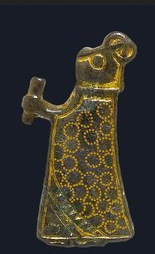 A viking figurine from Bornholm, Denmark, with the typical circular motifs found in silk fabric from Central Asia. Similar patterns were found in the graves in Sweden. Credit Annika Larsson
A viking figurine from Bornholm, Denmark, with the typical circular motifs found in silk fabric from Central Asia. Similar patterns were found in the graves in Sweden. Credit Annika Larsson
June 6, 2021
Tolkien and Coffee?
Imagine my surprise to learn that the college my son attends–Oberlin College–procures its coffee from Goldberry Roasting Company. Would J.R.R. approve? At least she is lovely….
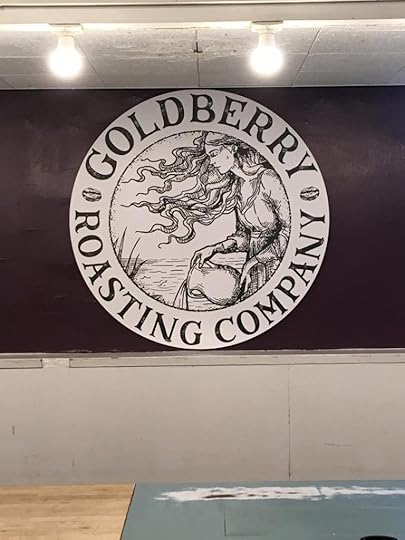
April 5, 2021
The Hobbit and Lord of the Rings: Soviet Style
A recent Guardian article has drawn attention to a late Soviet production of The Hobbit and LOTR!
 From World of Fantasy (in Russian Language)
From World of Fantasy (in Russian Language)Here is a short section of The Hobbit.
And check out this amazing LOTR!
March 24, 2021
Scholarly Analysis of “Grendel’s Mother: The Saga of the Wyrd-Wife”

Jolene Witkam’s MA Thesis in Philology from Leiden University
It is so interesting when one’s own novel becomes fodder for literary scholars to analyze. As a literary scholar myself, it is really fun to read. For example, I came across an MA thesis which analyzes Grendel’s Mother: Jolene Witkam’s MA Thesis in Philology from Leiden University. One of her advisors is none other than Dr. M. H. Porck, whose blog on Early English material and Old English is fantastic. Then there is Kathleen Forni’s Beowulf’s Popular Afterlife in Literature, Comic Books, and Film (Routledge, 2018). Forni calls my novel “a realistic and lyrically poetic version of a story….As Morrison’s elegant retelling attests, high art can also embody the experiences of the marginalized.” I’m delighted academics are able to take this novel and read it from theoretical and linguistic perspectives. I’m looking forward to seeing more in the future! Let me know if you come across any other such works.
February 5, 2021
Tolkien as “gateway drug”? And the winner is….
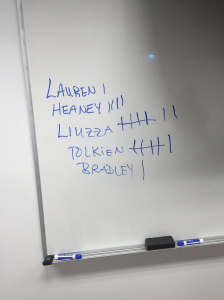
Photo by Cheyenne Johnston Ashton. The fateful tally…..
Whose the winner in a comparative translation exercise? My students had to argue for the best of four translations of Beowulf: Heaney, Bradley, Tolkien, or Liuzza. The students had excellent arguments for and against the various translators, all of whom had compelling artistic visions.
Many aspects were considered. What would be the best teaching text? What would draw the most diverse set of readers in? Should one strive for accuracy and authenticity or passion? My student Jessica writes that the translator needs to decide if the work to be translated should be a relic or a living art piece. Tolkien, Tyler points out, wrote in an archaic style, but the actual Beowulf poet was writing in a contemporary way for his audience. Thus, the translator of Beowulf today should do the same. The reader should be, according to Gaje, transported to the world of the poem.
Stephen argues that the “best translations are the ones that resonate with the translator. When the translator takes the story and recreates it; when the story is melted down and reforged to be true for the translator.” Tolkien’s love of Old English shines through.
One of my students, Rachel, wrote “Tolkien’s translation acts much like a gateway drug to obsession with Old English, easy and compelling to a point that hooks one and leaves them craving more.”
Jeremy suggests, “If the Liuzza translation is a classic Old English ale, the Heaney translation is a glass of finely balanced mead.” Skol!
And one of my grad students, Zach, is working on a translation for English language learners. His work is spectacular. I can’t wait to see what happens with that.
In the end, Liuzza won! But it was neck-and-neck until the last student’s presentation. Jeremy broke the tie in a wild finish!
One student–Lauren–chose her own translation. You go, girlfriend!
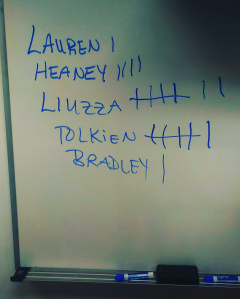
Photo by Joshua Gonzalez–who also lent me the first season of The Vikings
And while comparative translation may seem dry and dusty, several students claimed it was their favorite activity in the semester. One wrote, “I’m thankful to say that Old English literature helped me to translate my self from someone in a bad place to a happy and carefree person. Much like Tolkien’s translation of Beowulf, I’m looking to be a whimsical and adventurous individual….Texts and people are like little caterpillars that, with preparation and motivation, can turn into beautiful butterflies.”
Perfectly said!
December 24, 2020
Father Christmas and Tolkien
Tolkien loved to write letters from Father Christmas to his children. The Great Polar Bear is Father Christmas’s companion–who periodically causes merry havoc. As Elizabeth Hand writes in this article from The Washington Post,
As the years pass, Father Christmas takes note of the darkening world beyond the North Pole, as when he writes to 10-year-old Priscilla in 1939: “I am very busy and things are very difficult this year owing to this horrible war. Many of my messengers have never come back . . . Polar Bear has hardly done anything to help.” (“ROT!” Polar Bear retorts.)
You may wish to make these letters, Letters from Father Christmas, part of your Christmas tradition!
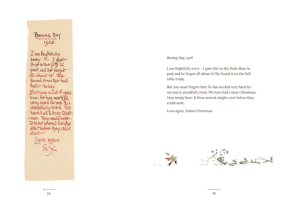 Correspondence from “Letters From Father Christmas, Centenary Edition” by J.R.R. Tolkien. (Copyright © The Tolkien Estate Limited and The Tolkien Trust. Provided by Houghton Mifflin Harcourt Books and Media.)
Correspondence from “Letters From Father Christmas, Centenary Edition” by J.R.R. Tolkien. (Copyright © The Tolkien Estate Limited and The Tolkien Trust. Provided by Houghton Mifflin Harcourt Books and Media.)




